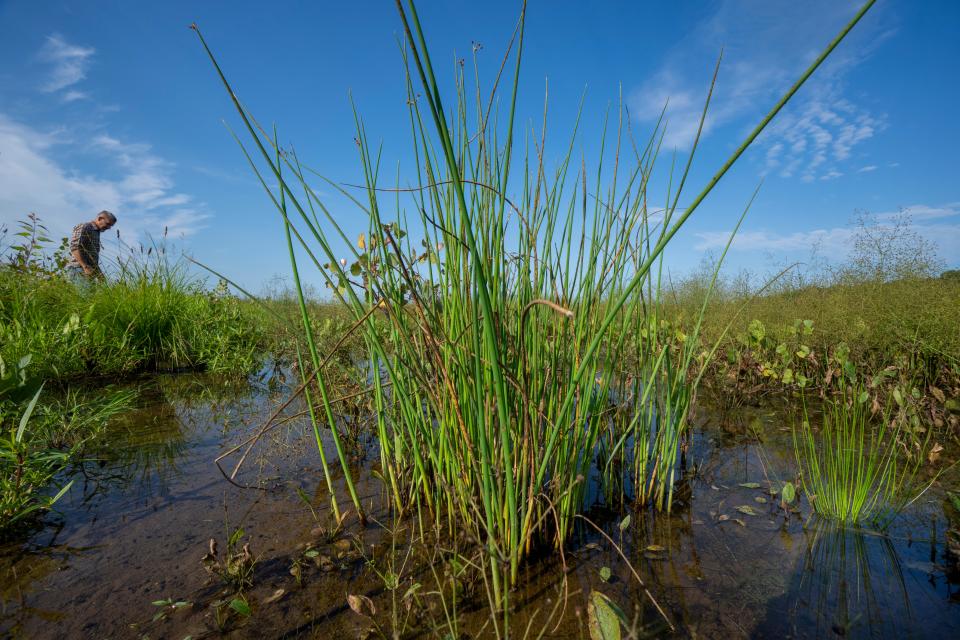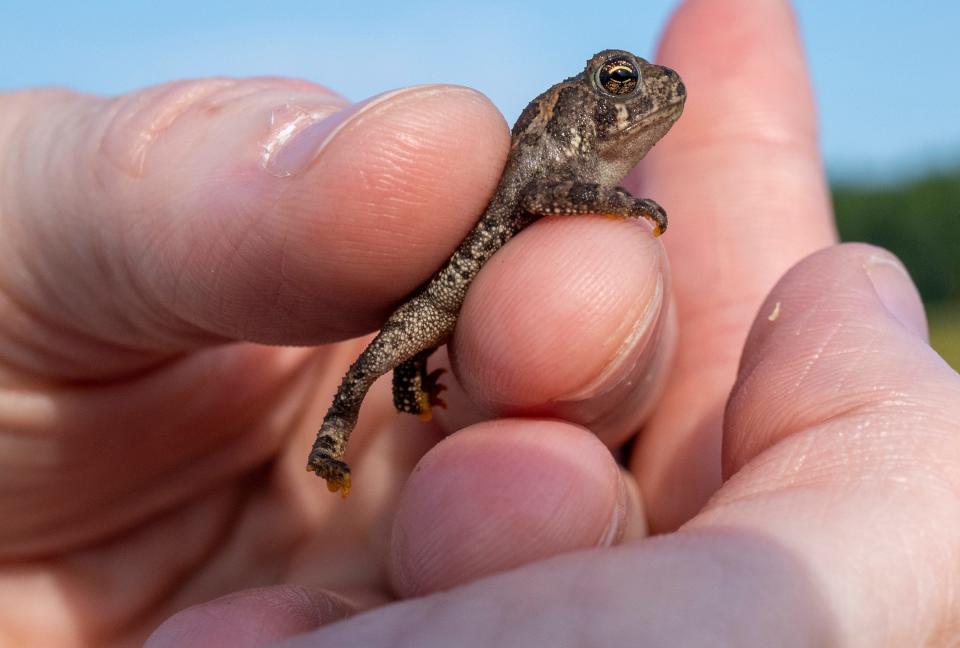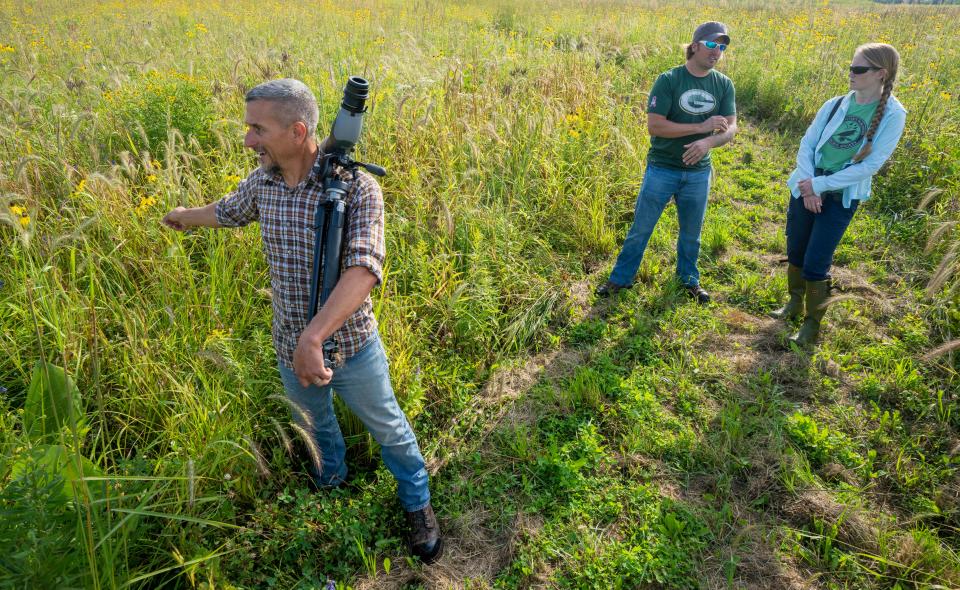‘The Earth is healing’: What a prairie restoration project on the Oneida Reservation can teach us about partnerships and the land
ONEIDA - The sound of car engines slowly slipped away as Tony Kuchma walked alongside canary-colored blooms of green-headed coneflowers that lined the trail. Stalks of prairie dock towered above.
The colors of the prairie signaled that summer was coming to an end: faded green, bright yellow with touches of purple peeking through.
Kuchma stopped suddenly, pointing toward the ground at a leopard frog that swiftly leaped into the dense grass.
“We’ve got everybody that should be here… it’s just coming alive,” said Kuchma, a project manager with Oneida Nation.
Leopard frogs. Mayflies. Bumblebees. Waterfowl. They’ve all found their way back here to the headwaters of Trout Creek on the Oneida Reservation thanks to Kuchma and his team, which starting in 2018 restored more than 400 acres of native habitat: prairie, wetland and forest.
Now, the mosaic landscape offers a refuge for grassland birds to breed and fledge their young as well as a stopover for migratory shorebirds and waterfowl. But it’s more than just a restoration project, the revived habitats are a cross-pollination of cultures, blending science and community.
Grassland birds are one of the most imperiled groups of birds in the country as their native habitat continues to be converted to farmland. In Wisconsin, less than 1 percent of original native grasslands remain.
“There's no grassland of this size or this quality within an hour and a half drive of this particular spot,” said Erin Giese, a partner on the project who studies birds at the University of Wisconsin-Green Bay.
The next closest native grassland is the Buena Vista Grasslands, nearly 90 miles away.
Giese leads a bird monitoring project on the restored habitats, a collaboration between Oneida Nation, Great Lakes Audubon and Northeastern Wisconsin Audubon. The project is in its second year. Expert volunteers who are birders go out three times per summer to see what birds are using the habitat. They also do a set of migration surveys twice a week during the summer to capture all the kinds of birds that come by. The roster varies based on the time of year, species, gender and age.
After only two years, Giese can’t believe how quickly the birds have come back. Over 50 volunteers have participated, counting over 40,000 birds from nearly 120 species.

Signs of a healthy habitat
Later that morning, Kuchma slowly took one step at a time down the trail toward the wetland, vigilant that with each step closer to the wetland the ground came alive with green and leopard frogs.
He handed his spotting scope to Giese so she could take a look at what kinds of birds were in the water that day. After a few moments of peering through, she saw an adult pied-billed grebe, a small water bird, with its young. She couldn’t hide her excitement.
The return of the pied-billed grebe is the sign that the wetland is healthy and can support marsh birds, she said, as she pointed out the other kinds of waterfowl hanging out in the water.
Giese said this was a “quiet time” of the year, in between nesting and breeding in early summer and just before the migration south. But you wouldn’t know it by the number of birds in the water and sky.
This summer the volunteers also spotted Eastern and Western meadowlarks, bobolinks, clay-colored sparrows and dickcissel.
But the real “brag bird,” Giese said, is the Henslow’s sparrow — an uncommon bird for the area that they’ve seen at a few of their monitoring points.
“Do I love this place for birds? Yeah, it's great,” said Giese. “But it also has this dual purpose,” she said, expressing that the project is breaking down barriers and elevating the voices of Indigenous people in the area.

Where science meets tradition
After losing millions of acres in their ancestral homeland in New York State, the Oneida Nation was forced to relocate to what is now Wisconsin two hundred years ago. In 1822 they signed a treaty with the Menominee tribe to jointly use millions of acres of land, which were also lost when their 65,000-acre reservation was established. Much of this reservation land has also been lost.
Slowly the Oneida Nation has been buying back their land and restoring it, helping to bring back their identity and traditions.
The restoration project blends Western science with traditional ecological knowledge — the relationships between all living things and the land, knowledge which Indigenous peoples have accumulated for thousands of years. It was important to Kuchma for tribal members to be able to use the land to collect resources and support their traditions.
“We’re seeing all these bugs, birds, animals coming back home,” said Randy Cornelius, an Oneida tribal elder and cultural educator, noting that when he grew up there were hardly any woods at all on the reservation.
“There are all these relationships that our Creator intended for us to have with the natural world and look at the natural world as an extended family,” he said.
Part of their teachings is to only take what is needed and not over-harvest, said Cornelius.
In the nearby reforested area, the team planted fruit and nut-bearing trees so tribal members have more opportunities to gather. They also planted hickory trees, which are used to make lacrosse sticks, an important tradition to the Oneida people.
Bergamot, also known as Number Six, is a medicine used for colds and now grows in the prairie. But it’s also filling another role: attracting rare pollinators.
Earlier this summer, Kuchma and his team found rusty patched bumblebees, a federally endangered species, hovering over the purple blooms. In fact, they’ve seen almost every kind of bee found in Wisconsin in the restored habitats.
“This land was ready for change,” said Kuchma.

Voices coming back
The Oneida Nation now manages the entire headwaters of Trout Creek, which drains into Duck Creek before making its way to the lower bay of Green Bay. Every summer, harmful algae blooms plague the bay, namely from agricultural pollution.
Restoring the headwaters is critical to maintaining water quality in the watershed, said Kuchma. Now, brook trout once again spawn at the Trout Creek headwaters.
A few weeks ago, Kuchma, Giese and Cornelius held a camp for kids in the tribe, letting them explore the prairie and learn about the plants and animals that live there. And every day Cornelius shared traditional stories about their creation.
In the fall, Kuchma wants to plant wild rice in the wetland, which also grows in another successfully restored wetland nearby. Later this winter the Oneida Nation will go through a formal process to name the restored prairie and wetland.
Another big goal of the project is to get the land recognized as an Important Bird Area, a designation as a critical habitat for birds from the Audubon Society, said Giese. This would help them get grants to fund more restoration work.
All of the birds, frogs, insects and plants that now call this place home are voices that they haven’t heard in generations coming back, said Cornelius.
“The Earth is healing,” he said. “And that’s a good thing.”
Caitlin Looby is a Report for America corps member who writes about the environment and the Great Lakes. Email her at clooby@gannett.com.
Please consider supporting journalism that informs our democracy with a tax-deductible gift to this reporting effort at jsonline.com/RFA.
This article originally appeared on Milwaukee Journal Sentinel: Restored Wisconsin habitat brings back birds on Oneida Reservation

